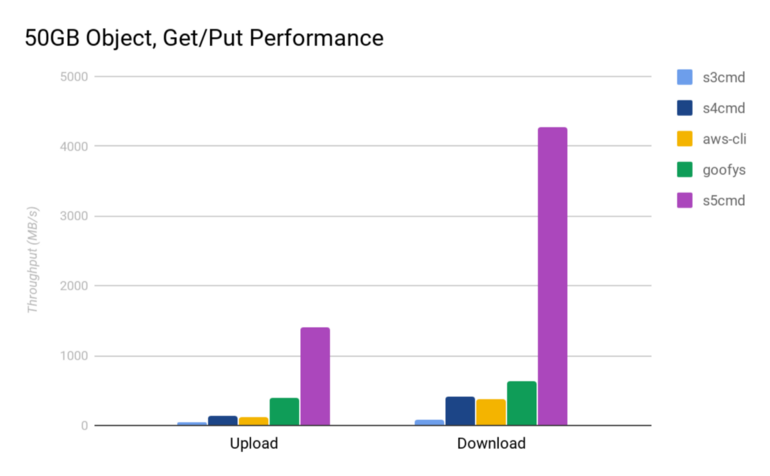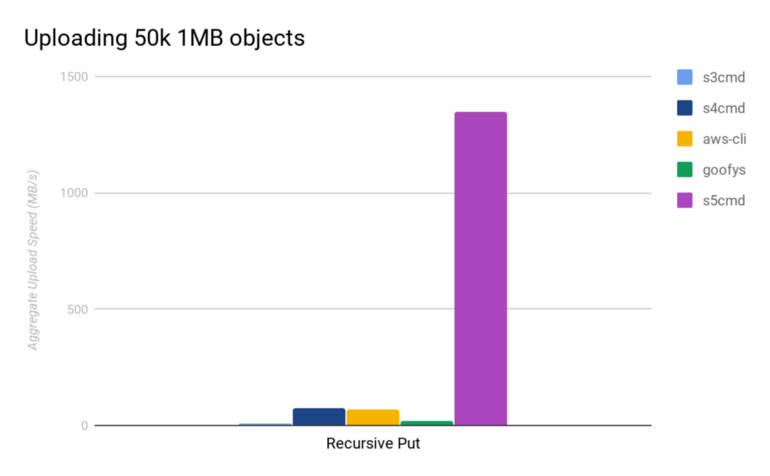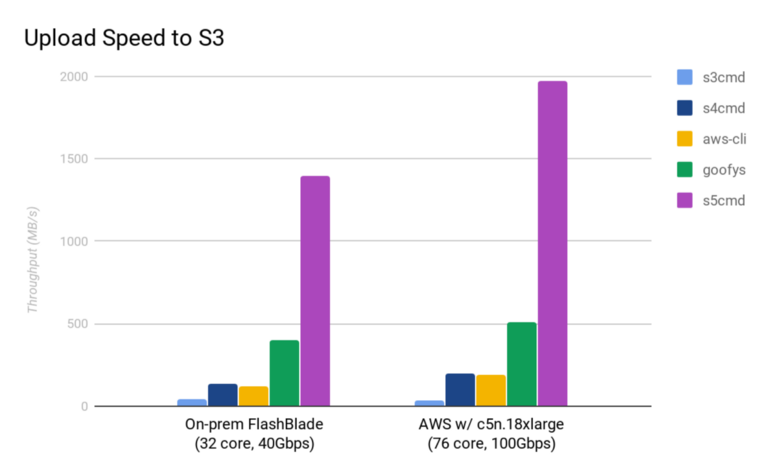peak / S5cmd
Programming Languages
Projects that are alternatives of or similar to S5cmd
s5cmd
Overview
s5cmd is a very fast S3 and local filesystem execution tool. It comes with support
for a multitude of operations including tab completion and wildcard support
for files, which can be very handy for your object storage workflow while working
with large number of files.
There are already other utilities to work with S3 and similar object storage
services, thus it is natural to wonder what s5cmd has to offer that others don't.
In short, s5cmd offers a very fast speed.
Thanks to Joshua Robinson for his
study and experimentation on s5cmd; to quote his medium post:
For uploads, s5cmd is 32x faster than s3cmd and 12x faster than aws-cli. For downloads, s5cmd can saturate a 40Gbps link (~4.3 GB/s), whereas s3cmd and aws-cli can only reach 85 MB/s and 375 MB/s respectively.
If you would like to know more about performance of s5cmd and the
reasons for its fast speed, refer to benchmarks section
Features
s5cmd supports wide range of object management tasks both for cloud
storage services and local filesystems.
- List buckets and objects
- Upload, download or delete objects
- Move, copy or rename objects
- Set Server Side Encryption using AWS Key Management Service (KMS)
- Set Access Control List (ACL) for objects/files on the upload, copy, move.
- Print object contents to stdout
- Create buckets
- Summarize objects sizes, grouping by storage class
- Wildcard support for all operations
- Multiple arguments support for delete operation
- Command file support to run commands in batches at very high execution speeds
- Dry run support
- S3 Transfer Acceleration support
- Google Cloud Storage (and any other S3 API compatible service) support
- Structured logging for querying command outputs
- Shell auto-completion
Installation
Binaries
The Releases page provides pre-built binaries for Linux and macOS.
Homebrew
For macOS, a homebrew tap is provided:
brew tap peak/s5cmd https://github.com/peak/s5cmd
brew install s5cmd
Build from source
You can build s5cmd from source if you have Go 1.13+
installed.
go get github.com/peak/s5cmd
⚠️ Please note that building from master is not guaranteed to be stable since
development happens on master branch.
Docker
Hub
$ docker pull peakcom/s5cmd
$ docker run --rm -v ~/.aws:/root/.aws peakcom/s5cmd <S3 operation>
Build
$ git clone https://github.com/peak/s5cmd && cd s5cmd
$ docker build -t s5cmd .
$ docker run --rm -v ~/.aws:/root/.aws s5cmd <S3 operation>
Usage
s5cmd supports multiple-level wildcards for all S3 operations. This is
achieved by listing all S3 objects with the prefix up to the first wildcard,
then filtering the results in-memory. For example, for the following command;
s5cmd cp 's3://bucket/logs/2020/03/*' .
first a ListObjects request is send, then the copy operation will be executed
against each matching object, in parallel.
Examples
Download a single S3 object
s5cmd cp s3://bucket/object.gz .
Download multiple S3 objects
Suppose we have the following objects:
s3://bucket/logs/2020/03/18/file1.gz
s3://bucket/logs/2020/03/19/file2.gz
s3://bucket/logs/2020/03/19/originals/file3.gz
s5cmd cp 's3://bucket/logs/2020/03/*' logs/
s5cmd will match the given wildcards and arguments by doing an efficient
search against the given prefixes. All matching objects will be downloaded in
parallel. s5cmd will create the destination directory if it is missing.
logs/ directory content will look like:
$ tree
.
└── logs
├── 18
│ └── file1.gz
└── 19
├── file2.gz
└── originals
└── file3.gz
4 directories, 3 files
ℹ️ s5cmd preserves the source directory structure by default. If you want to
flatten the source directory structure, use the --flatten flag.
s5cmd cp --flatten 's3://bucket/logs/2020/03/*' logs/
logs/ directory content will look like:
$ tree
.
└── logs
├── file1.gz
├── file2.gz
└── file3.gz
1 directory, 3 files
Upload a file to S3
s5cmd cp object.gz s3://bucket/
by setting server side encryption (aws kms) of the file:
s5cmd cp -sse aws:kms -sse-kms-key-id <your-kms-key-id> object.gz s3://bucket/
by setting Access Control List (acl) policy of the object:
s5cmd cp -acl bucket-owner-full-control object.gz s3://bucket/
Upload multiple files to S3
s5cmd cp directory/ s3://bucket/
Will upload all files at given directory to S3 while keeping the folder hierarchy of the source.
Delete an S3 object
s5cmd rm s3://bucket/logs/2020/03/18/file1.gz
Delete multiple S3 objects
s5cmd rm s3://bucket/logs/2020/03/19/*
Will remove all matching objects:
s3://bucket/logs/2020/03/19/file2.gz
s3://bucket/logs/2020/03/19/originals/file3.gz
s5cmd utilizes S3 delete batch API. If matching objects are up to 1000,
they'll be deleted in a single request. However, it should be noted that commands such as
s5cmd rm s3://bucket-foo/object s3://bucket-bar/object
are not supported by s5cmd and result in error (since we have 2 different buckets), as it is in odds with the benefit of performing batch delete requests. Thus, if in need, one can use s5cmd run mode for this case, i.e,
$ s5cmd run
rm s3://bucket-foo/object
rm s3://bucket-bar/object
more details and examples on s5cmd run are presented in a later section.
Copy objects from S3 to S3
s5cmd supports copying objects on the server side as well.
s5cmd cp 's3://bucket/logs/2020/*' s3://bucket/logs/backup/
Will copy all the matching objects to the given S3 prefix, respecting the source folder hierarchy.
⚠️ Copying objects (from S3 to S3) larger than 5GB is not supported yet. We have an open ticket to track the issue.
Count objects and determine total size
$ s5cmd du --humanize 's3://bucket/2020/*'
30.8M bytes in 3 objects: s3://bucket/2020/*
Run multiple commands in parallel
The most powerful feature of s5cmd is the commands file. Thousands of S3 and
filesystem commands are declared in a file (or simply piped in from another
process) and they are executed using multiple parallel workers. Since only one
program is launched, thousands of unnecessary fork-exec calls are avoided. This
way S3 execution times can reach a few thousand operations per second.
s5cmd run commands.txt
or
cat commands.txt | s5cmd run
commands.txt content could look like:
cp s3://bucket/2020/03/* logs/2020/03/
# line comments are supported
rm s3://bucket/2020/03/19/file2.gz
# empty lines are OK too like above
# rename an S3 object
mv s3://bucket/2020/03/18/file1.gz s3://bucket/2020/03/18/original/file.gz
# list all buckets
ls # inline comments are OK too
Dry run
--dry-run flag will output what operations will be performed without actually
carrying out those operations.
s3://bucket/pre/file1.gz
...
s3://bucket/last.txt
running
s5cmd --dry-run cp s3://bucket/pre/* s3://another-bucket/
will output
cp s3://bucket/pre/file1.gz s3://another-bucket/file1.gz
...
cp s3://bucket/pre/last.txt s3://anohter-bucket/last.txt
however, those copy operations will not be performed. It is displaying what
s5cmd will do when ran without --dry-run
Note that --dry-run can be used with any operation that has a side effect, i.e.,
cp, mv, rm, mb ...
Specifying credentials
s5cmd uses official AWS SDK to access S3. SDK requires credentials to sign
requests to AWS. Credentials can be provided in a variety of ways:
- Environment variables
- AWS credentials file, including profile selection via
AWS_PROFILEenvironment variable - If
s5cmdruns on an Amazon EC2 instance, EC2 IAM role - If
s5cmdruns on EKS, Kube IAM role
The SDK detects and uses the built-in providers automatically, without requiring manual configurations.
Shell auto-completion
Shell completion is supported for bash, zsh and fish.
To enable auto-completion, run:
s5cmd --install-completion
This will add a few lines to your shell configuration file. After installation, restart your shell to activate the changes.
Google Cloud Storage support
s5cmd supports S3 API compatible services, such as GCS, Minio or your favorite
object storage.
s5cmd --endpoint-url https://storage.googleapis.com ls
will return your GCS buckets.
s5cmd will use virtual-host style bucket resolving for S3, S3 transfer
acceleration and GCS. If a custom endpoint is provided, it'll fallback to
path-style.
Retry logic
s5cmd uses an exponential backoff retry mechanism for transient or potential
server-side throttling errors. Non-retriable errors, such as invalid credentials, authorization errors etc, will not be retried. By default,
s5cmd will retry 10 times for up to a minute. Number of retries are adjustable
via --retry-count flag.
ℹ️ Enable debug level logging for displaying retryable errors.
Using wildcards
Most shells can attempt to expand wildcards before passing the arguments to
s5cmd, resulting in surprising no matches found errors.
To avoid this problem, surround the wildcarded expression with single quotes.
Output
s5cmd supports both structured and unstructured outputs.
- unstructured output
$ s5cmd cp s3://bucket/testfile .
cp s3://bucket/testfile testfile
$ s5cmd cp --no-clobber s3://somebucket/file.txt file.txt
ERROR "cp s3://somebucket/file.txt file.txt": object already exists
- If
--jsonflag is provided:
{
"operation": "cp",
"success": true,
"source": "s3://bucket/testfile",
"destination": "testfile",
"object": "[object]"
}
{
"operation": "cp",
"job": "cp s3://somebucket/file.txt file.txt",
"error": "'cp s3://somebucket/file.txt file.txt': object already exists"
}
Benchmarks
Some benchmarks regarding the performance of s5cmd are introduced below. For more
details refer to this post
which is the source of the benchmarks to be presented.
Upload/download of single large file

Uploading large number of small-sized files

Performance comparison on different hardware

So, where does all this speed come from?
There are mainly two reasons for this:
- It is written in Go, a statically compiled language designed to make development of concurrent systems easy and make full utilization of multi-core processors.
-
Parallelization.
s5cmdstarts out with concurrent worker pools and parallelizes workloads as much as possible while trying to achieve maximum throughput.
Advanced Usage
Some of the advanced usage patterns provided below are inspired by the following article (thank you! @joshuarobinson)
Integrate s5cmd operations with Unix commands
Assume we have a set of objects on S3, and we would like to list them in sorted fashion according to object names.
$ s5cmd ls s3://bucket/reports/ | sort -k 4
2020/08/17 09:34:33 1364 antalya.csv
2020/08/17 09:34:33 0 batman.csv
2020/08/17 09:34:33 23114 istanbul.csv
2020/08/17 09:34:33 26154 izmir.csv
2020/08/17 09:34:33 112 samsun.csv
2020/08/17 09:34:33 12552 van.csv
For a more practical scenario, let's say we have an avocado prices dataset, and we would like to take a peek at the few lines of the data by fetching only the necessary bytes.
$ s5cmd cat s3://bucket/avocado.csv.gz | gunzip | xsv slice --len 5 | xsv table
Date AveragePrice Total Volume 4046 4225 4770 Total Bags Small Bags Large Bags XLarge Bags type year region
0 2015-12-27 1.33 64236.62 1036.74 54454.85 48.16 8696.87 8603.62 93.25 0.0 conventional 2015 Albany
1 2015-12-20 1.35 54876.98 674.28 44638.81 58.33 9505.56 9408.07 97.49 0.0 conventional 2015 Albany
2 2015-12-13 0.93 118220.22 794.7 109149.67 130.5 8145.35 8042.21 103.14 0.0 conventional 2015 Albany
3 2015-12-06 1.08 78992.15 1132.0 71976.41 72.58 5811.16 5677.4 133.76 0.0 conventional 2015 Albany
4 2015-11-29 1.28 51039.6 941.48 43838.39 75.78 6183.95 5986.26 197.69 0.0 conventional 2015 Albany
Beast Mode s5cmd
s5cmd allows to pass in some file, containing list of operations to be performed, as an argument to the run command as illustrated in the above example. Alternatively, one can pipe in commands into
the run:
BUCKET=s5cmd-test; s5cmd ls s3://$BUCKET/*test | grep -v DIR | awk ‘{print $NF}’
| xargs -I {} echo “cp s3://$BUCKET/{} /local/directory/” | s5cmd run
The above command performs two s5cmd invocations; first, searches for files with test suffix and then creates a copy to local directory command for each matching file and finally, pipes in those into the run.
Let's examine another usage instance, where we migrate files older than 30 days to a cloud object storage:
find /mnt/joshua/nachos/ -type f -mtime +30 | xargs -I{} echo “mv {} s3://joshuarobinson/backup/{}”
| s5cmd run
It is worth to mention that, run command should not be considered as a silver bullet for all operations. For example, assume we want to remove the following objects:
s3://bucket/prefix/2020/03/object1.gz
s3://bucket/prefix/2020/04/object1.gz
...
s3://bucket/prefix/2020/09/object77.gz
Rather than executing
rm s3://bucket/prefix/2020/03/object1.gz
rm s3://bucket/prefix/2020/04/object1.gz
...
rm s3://bucket/prefix/2020/09/object77.gz
with run command, it is better to just use
rm s3://bucket/prefix/2020/0*/object*.gz
the latter sends single delete request per thousand objects, whereas using the former approach
sends a separate delete request for each subcommand provided to run. Thus, there can be a
significant runtime difference between those two approaches.
LICENSE
MIT. See LICENSE.

